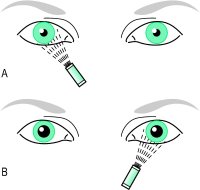Marcus Gunn pupil (relative afferent pupillary defect) is a medical sign observed during the swinging-flashlight test whereupon the patient's pupils constrict less (therefore appearing to dilate) when a bright light is swung from the unaffected eye to the affected eye. The affected eye still senses the light and produces pupillary sphincter constriction to some degree, albeit reduced.
The most common cause of Marcus Gunn pupil is a lesion of the optic nerve (distal to the optic chiasm) or severe retinal disease. It is named after Scottish ophthalmologist Robert Marcus Gunn.
Examination
The Marcus Gunn pupil is a relative afferent pupillary defect indicating a decreased pupillary response to light in the affected eye.
In the swinging flashlight test, a light is alternately shone into the left and right eyes. A normal response would be equal constriction of both pupils, regardless of which eye the light is directed at. This indicates an intact direct and consensual pupillary light reflex. When the test is performed in an eye with an afferent pupillary defect, light directed in the affected eye will cause only mild constriction of both pupils (due to decreased response to light from the afferent defect), while light in the unaffected eye will cause a normal constriction of both pupils (due to an intact afferent path, and an intact consensual pupillary reflex). Thus, light shone in the affected eye will produce less pupillary constriction than light shone in the unaffected eye.
A Marcus Gunn Pupil is distinguished from a total CN II lesion, in which the affected eye perceives no light. In that case, shining the light in the affected eye produces no effect.
Anisocoria is absent. A Marcus Gunn pupil is seen, among other conditions, in optic neuritis.
Find free medical videos , tutorials and power point presentations and more of free medical content .....
Midaortic Syndrome - Video
What is midaortic disorder? Midaortic disorder could be a exceptionally uncommon condition in which portion of the aorta (the heart...

-
1. What is the difference between Cushing’s Syndrome and Cushing’s Disease? Any condition that causes the adrenal gland to produce ...
-
Hand washing, otherwise called hand cleanliness, is the demonstration of cleaning one's hands with cleanser and clean water to ...
-
The prostate (from Greek προστάτης - prostates, literally "one who stands before", "protector", "guardian"[...
